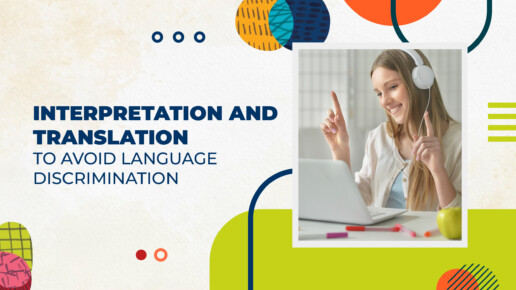Interpretation and Translation to Avoid Language Discrimination
In our increasingly interconnected world, effective communication is essential for fostering understanding and cooperation among individuals from diverse linguistic backgrounds. However, language barriers often pose significant challenges, leading to miscommunication and, in some cases, discrimination. In this article, we explore the crucial role of interpretation and translation in mitigating language discrimination and promoting inclusivity.
Introduction
Defining interpretation and translation
Interpretation involves orally conveying the meaning of spoken words from one language to another, facilitating communication between individuals who do not share a common language. Translation, on the other hand, involves the written transfer of text from one language to another. Both interpretation and translation play vital roles in bridging linguistic divides and ensuring effective communication across cultures.
Importance of effective communication
Effective communication is the cornerstone of a fair and just society. It enables individuals to access essential services, participate fully in civic life, and exercise their rights. However, when individuals face language barriers, they may encounter difficulties in accessing healthcare, legal assistance, education, and other critical services, leading to marginalization and discrimination.
The role of interpretation and translation in avoiding language discrimination
Breaking language barriers
Interpretation and translation services play a crucial role in breaking down language barriers and facilitating communication between individuals who speak different languages. By providing accurate and timely language assistance, interpreters and translators help ensure that all individuals can access information and services regardless of their linguistic background.
Ensuring equal access to services
Language discrimination occurs when individuals are denied access to services or opportunities due to their inability to communicate effectively in a particular language. Interpretation and translation services help prevent such discrimination by enabling individuals to fully understand their rights and responsibilities and access essential services in their preferred language.
Promoting inclusivity
By facilitating communication between individuals from diverse linguistic backgrounds, interpretation and translation services promote inclusivity and diversity. They empower individuals to participate fully in society, contribute to their communities, and access opportunities for personal and professional growth without facing language-based barriers.
Challenges in interpretation and translation
Cultural nuances
Interpretation and translation require more than just linguistic proficiency; they also necessitate an understanding of cultural nuances and context. Translators and interpreters must be sensitive to cultural differences and ensure that their communication accurately reflects the intended meaning across languages and cultures.
Accuracy and precision
Maintaining accuracy and precision in interpretation and translation can be challenging, especially when dealing with complex or specialized subject matter. Errors or inaccuracies in translation can lead to misunderstandings or misinterpretations, potentially exacerbating language barriers and contributing to discrimination.
Availability of qualified professionals
One of the significant challenges in interpretation and translation is the availability of qualified professionals, particularly in languages that are less commonly spoken or understood. Limited access to qualified interpreters and translators can impede individuals’ ability to access essential services and participate fully in society.
Strategies for effective interpretation and translation
Training and certification
Training and certification programs play a vital role in ensuring the quality and professionalism of interpreters and translators. By providing comprehensive training and certification opportunities, organizations can equip language professionals with the skills and knowledge necessary to deliver accurate and effective interpretation and translation services.
Utilizing technology
Advancements in technology have revolutionized the field of interpretation and translation, offering innovative tools and platforms for language assistance. From real-time interpretation apps to machine translation software, technology can enhance the efficiency and accessibility of interpretation and translation services, particularly in remote or underserved areas.
Culturally sensitive approach
A culturally sensitive approach is essential in interpretation and translation to ensure that communication is respectful and inclusive of diverse cultural perspectives. Interpreters and translators must be aware of cultural differences and avoid imposing their own cultural biases or assumptions onto the communication process.
Case studies showcasing successful interpretation and translation practices
Healthcare settings
In healthcare settings, interpretation and translation services are critical for ensuring effective communication between healthcare providers and patients with limited English proficiency. By providing language assistance, healthcare organizations can improve patient outcomes, enhance patient satisfaction, and reduce disparities in access to care.
Legal proceedings
In legal proceedings, accurate interpretation and translation are essential for safeguarding individuals’ rights and ensuring fair and impartial justice. Qualified interpreters and translators play a crucial role in facilitating communication between parties, translating legal documents, and interpreting courtroom proceedings accurately and impartially.
Educational institutions
In educational institutions, interpretation and translation services are vital for ensuring that all students have equal access to education and opportunities for academic success. By providing language assistance to students and their families, schools can create inclusive learning environments and support students in achieving their full potential.
Conclusion
Interpretation and translation are powerful tools for breaking down language barriers, promoting inclusivity, and combating language discrimination. By ensuring effective communication across linguistic divides, interpreters and translators play a crucial role in creating a more equitable and inclusive society where all individuals can access opportunities and services regardless of their language background.

